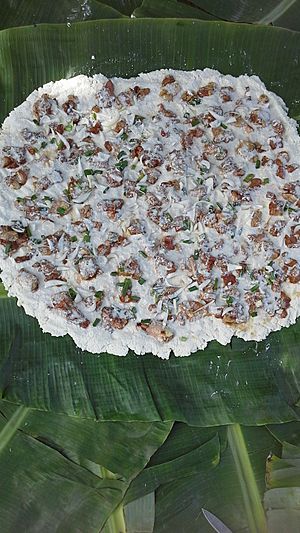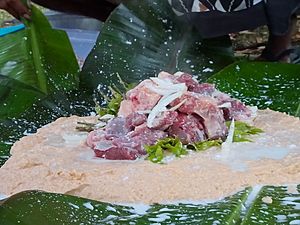Vanuatuan cuisine facts for kids

The cuisine of Vanuatu is also known as aelan kakae in the local language, Bislama. It uses fresh ingredients like fish, root vegetables such as taro and yams, fruits, and other vegetables. Most families in Vanuatu grow their own food in gardens. This means they usually have plenty to eat.
Fruits like papayas, pineapples, mangoes, plantains, and sweet potatoes are common all year. Coconut milk and cream add flavor to many meals. People often cook food using hot stones, or by boiling and steaming it. Frying food is not very common. Vanuatu's food has many different influences because of its history with other countries.
Contents
Main Ingredients in Vanuatu Food
Vanuatu dishes use many basic ingredients. These include yam, taro, bananas, coconuts, sugarcane, and tropical nuts. They also use pigs, green leafy vegetables, chickens, and seafood. Most local people in Vanuatu grow their own food. They only buy things like rice or canned fish from stores.
Kava: A Special Drink
Kava is a traditional drink that is very popular in Vanuatu. It is made from a plant called Piper methysticum. Kava is not alcoholic. It can make you feel relaxed. People usually drink it in the evening, before dinner. It's often enjoyed by men, but more women are drinking it now too.
Kava is important for social gatherings. People drink it in special places called nakamals. It helps people relax and talk together. Kava is well-known across the South Pacific. It is strongly connected to old traditions and beliefs. It's a popular way to relax from daily life.
Traditional Dishes of Vanuatu

The national dish of Vanuatu is called lap lap. It is a baked pudding. To make it, people grate yam, banana, manioc, or taro. They mix it with coconut milk and salt. Then, they wrap it in banana leaves. Finally, they bake it under hot volcanic stones.
There are many kinds of lap lap, depending on the island. On Malekula island, they have a special way to bake it called 'Sosor'. They put a glowing hot stone in the middle of the pudding. Chicken wings, onion, and tomato go on top of the stone. Then, they pour coconut milk over everything. After wrapping and baking, they remove the stone. The meat is cooked by the steam from the coconut milk. They make a small well in the center of the pudding and add more coconut milk as a dipping sauce. You can often find lap lap with toppings like chicken, beef, octopus, or fried fish at local markets.
Another popular dish is simboro. This is a steamed roll made from grated banana, manioc, yam, taro, or flour. It's wrapped in banana leaves and covered in coconut milk.
Sometimes, flying foxes are also caught and used in meals on some islands.
The traditional diet also includes many sea animals. Many villages near the coast, lakes, or rivers have skilled fishermen. They catch all kinds of shellfish, deep-sea fish, and reef fish for their meals. Fishermen are praised if they can catch big fish like Tuna, Barracuda, or Marlin using old methods. Other common seafood includes Red Emperor, Parrotfish, Cod, Trevally, small shellfish called common periwinkle, lobster, and sandcrabs.
The Coconut crab is also a special food in Vanuatu. However, many restaurants have stopped serving it. This is because the crab is at risk of disappearing.
Modern Food in Vanuatu
During the time when France and Britain ruled Vanuatu, many people came from other countries. Some came from Vietnam, Wallis & Futuna, Fiji, China, New Zealand, Australia, and Europe. These groups often lived in the main cities like Port Vila. They brought new foods with them, such as French breads, Vietnamese spring rolls (called 'Nems'), and fried doughnuts (called 'gateau huit').
These new foods are still popular in Vanuatu today, even after it became an independent country.
The growing tourism industry has also led to more Western restaurants in cities. You can find common Western foods like 'Chicken and Chips' or 'Pizza'. Asian dishes like 'Fried Rice' and 'Stir-Fried' meats are also available. However, these are often seen as expensive treats for local people.
More people are moving from the islands to the cities. They often live in rented homes with little space for gardening. Because of busy modern life, many city dwellers now buy convenient foods like canned goods. These foreign, processed foods have been linked to a rise in health issues.
Vanuatu does not have many large farm animals for food. The pig is a very important animal in traditions. It is usually eaten at big feasts and events. Pigs were likely brought to the islands by early settlers, like the Lapita people, along with chickens. Cows and goats were brought by European colonists. Now, raising cattle is a growing business for Vanuatu. Beef and chicken are also part of the daily diet.
See also
 In Spanish: Gastronomía de Vanuatu para niños
In Spanish: Gastronomía de Vanuatu para niños

